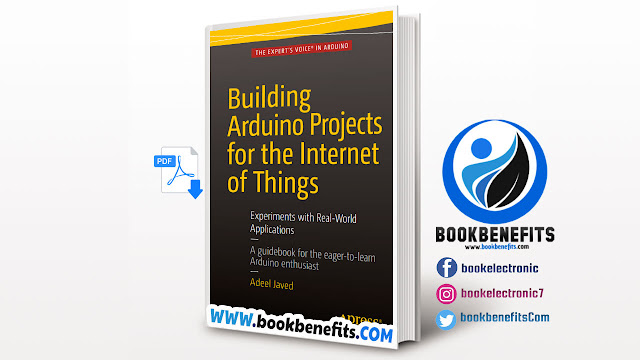Download Building Arduino Projects for the Internet of Things PDF
Building Arduino Projects for the Internet of Things PDF
Picture Of The Book :
Building Arduino Projects for the Internet of Things
About Of The Book :
This book is intended for amateurs and professionals who want to enter the world of IoT.
The content in this book requires prior knowledge of Arduino or similar peripherals and programming. We use basic hardware components and also provide step-by-step instructions for building the circuit. We kept the code simple, readable and minimal to help beginners understand concepts and create actionable content prototypes. Throughout the book, the code is consistent and, whenever necessary, available
explained in detail.
This book is based on my personal experience getting started with IoT. It was divided into sections
two sides make sense. The first one teaches the basics of creating IoT applications and the second section follows a project-based approach. At the end of each chapter, you will have type of service of IoT applications.
Analysts predict that by 2020, more than 50 billion people will be connected things (devices) and the Internet of Things (IoT) collection will be easier to access $1.5 trillion.
This number seems amazing, but what is IoT? It's just something connected to the internet? Why is connectedness important? IoT is more than anything connected to the Internet. IoT is all about being crazy the most intelligent thing by giving them the ability to understand, communicate and react. We have five sense - we can see, hear, taste, smell and touch. Likewise, if you add these sensors to things
they can do the same. For example, using a camera can see, using sound detection of things that can hear, with the help of a microphone, things that can speak. There are many other sensors and things can be used for more than us. By connecting these things to the Internet, they can communicate with us, and more, in the next territory where they can use Intelligence thinks too. There are many IoT applications, but here is one Some examples to better understand how IoT can improve our lives:
• Bracelets can monitor your vital signs. If he finds something Unlike normal people, it can make you and your doctor know right away.
• A security system that monitors the premises of your home any entry and warn you in the security office.
Part 1: Building Blocks
Chapters 1-3 cover the building blocks of IoT:
• Chapter 1, “Arduino Basics,” introduces the Arduino prototyping platform, which is used throughout the book.
• Chapter 2, “Internet Connectivity,” discusses the different options available for connecting things to the Internet.
• Chapter 3, “Communication Protocols,” teaches you what communication protocols are and which ones are available for IoT.
Part 2: Prototypes
Chapters 4-12 use the information covered in Part 1 to build prototypes of IoT applications.
• Chapter 4, “Complex Flows: Node-RED,” introduces Node-RED, which is a visual designer that helps reduce the amount of code required for IoT applications.
• Chapter 5, “IoT Patterns: Realtime Clients,” talks about components required for building IoT applications that provide data to users in real time and shows you how to build an intrusion detection system as an example.
• Chapter 6, “IoT Patterns: Remote Control,” discusses components of IoT applications that can remotely control things, such as a lighting control system.
• Chapter 7, “IoT Patterns: On-Demand Clients,” shows you different components involved in building an on-demand IoT application. You’ll build a smarter parking system in this chapter.
• Chapter 8, “IoT Patterns: Web Apps,” teaches you scenarios where web clients are preferred and uses a temperature monitoring system as an example.
• Chapter 9, “IoT Patterns: Location-Aware Devices,” discusses importance of location-aware devices. You’ll develop a livestock tracking system as an example.
• Chapter 10, “IoT Patterns: Machine to Human,” talks about scenarios where human response is needed; you’ll build a waste management system as an example.
• Chapter 11, “IoT Patterns: Machine to Machine,” discusses a pattern of IoT that is going to be very popular as things get smarter. The example is an energy conservation system.
• Chapter 12, “IoT Platforms,” wraps up the book by introducing you to IoT platforms that help expedite entry into IoT. The example in this chapter builds a soil moisture control system.
Contents Of The Book :
Part 1: Building Blocks
Chapter 1: Arduino Basics
Chapter 2: Internet Connectivity
Chapter 3: Communication Protocols
Part 2: Prototypes
Chapter 4: Complex Flows: Node-RED
Chapter 5: IoT Patterns: Realtime Clients
Chapter 6: IoT Patterns: Remote Control
Chapter 7: IoT Patterns: On-Demand Clients
Chapter 8: IoT Patterns: Web Apps
Chapter 9: IoT Patterns: Location Aware
Chapter 10: IoT Patterns: Machine to Human
Chapter 11: IoT Patterns: Machine to Machine
Chapter 12: IoT Platforms
Information Of The Book :
Title: Building Arduino Projects for the Internet of Things Download PDF
Size: 17 Mb
Pages: 299
Year : 2016
Format: PDF
Language : English
Author: Adeel Javed

